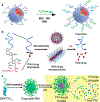Spherical Nucleic Acid Nanoparticles: Therapeutic Potential
- PMID: 29959665
- PMCID: PMC6428072
- DOI: 10.1007/s40259-018-0290-5
Spherical Nucleic Acid Nanoparticles: Therapeutic Potential
Abstract
Spherical nucleic acids (SNAs) are highly oriented, well organized, polyvalent structures of nucleic acids conjugated to hollow or solid core nanoparticles. Because they can transfect many tissue and cell types without toxicity, induce minimum immune response, and penetrate various biological barriers (such as the skin, blood-brain barrier, and blood-tumor barrier), they have become versatile tools for the delivery of nucleic acids, drugs, and proteins for various therapeutic purposes. This article describes the unique structures and properties of SNAs and discusses how these properties enable their application in gene regulation, immunomodulation, and drug and protein delivery. It also summarizes current efforts towards clinical translation of SNAs and provides an expert opinion on remaining challenges to be addressed in the path forward to the clinic.
Conflict of interest statement
Conflict of interest
CHK, JRM and ESD have no conflicts of interest to declare.
Figures







References
Publication types
MeSH terms
Substances
Grants and funding
LinkOut - more resources
Full Text Sources
Other Literature Sources

